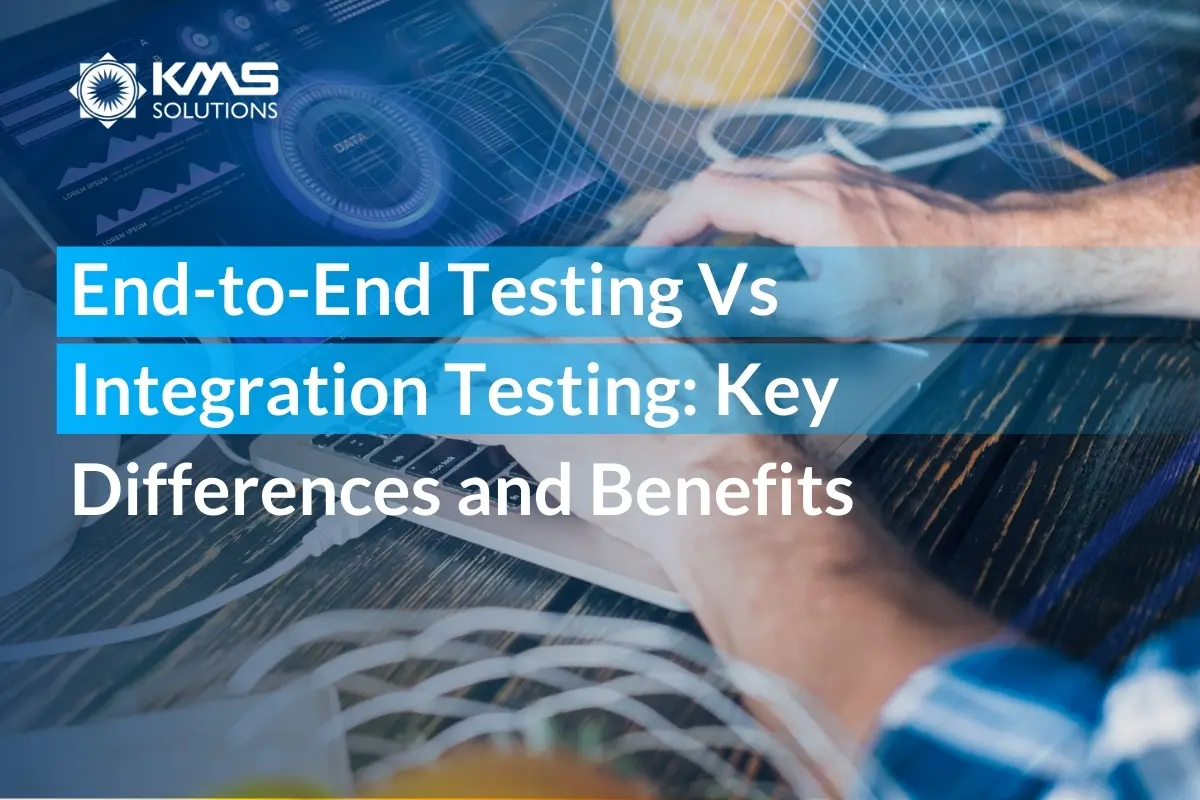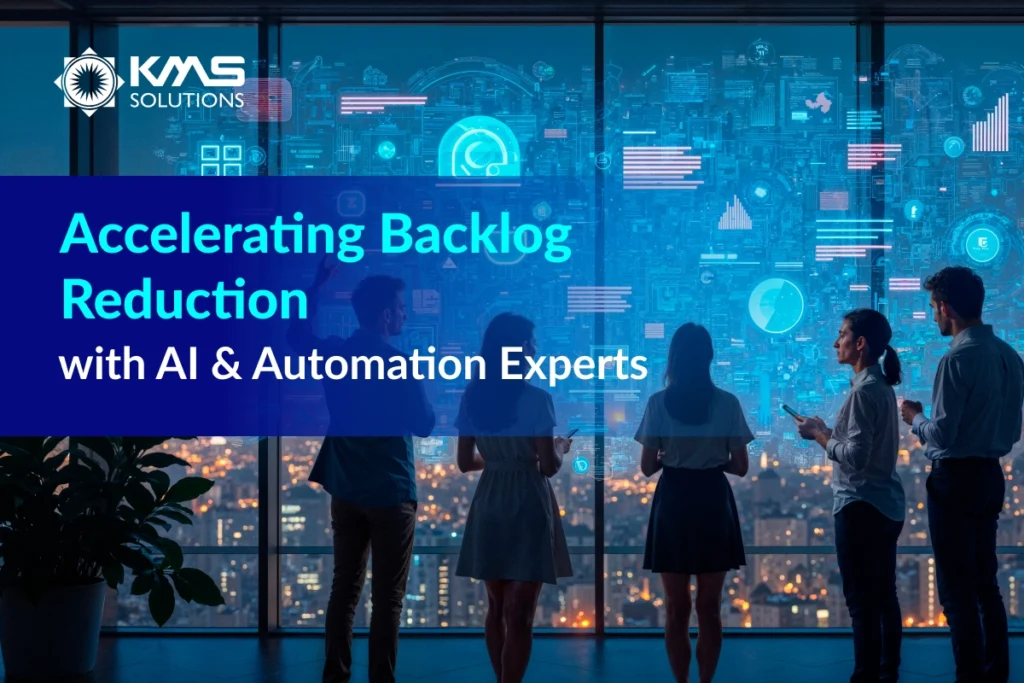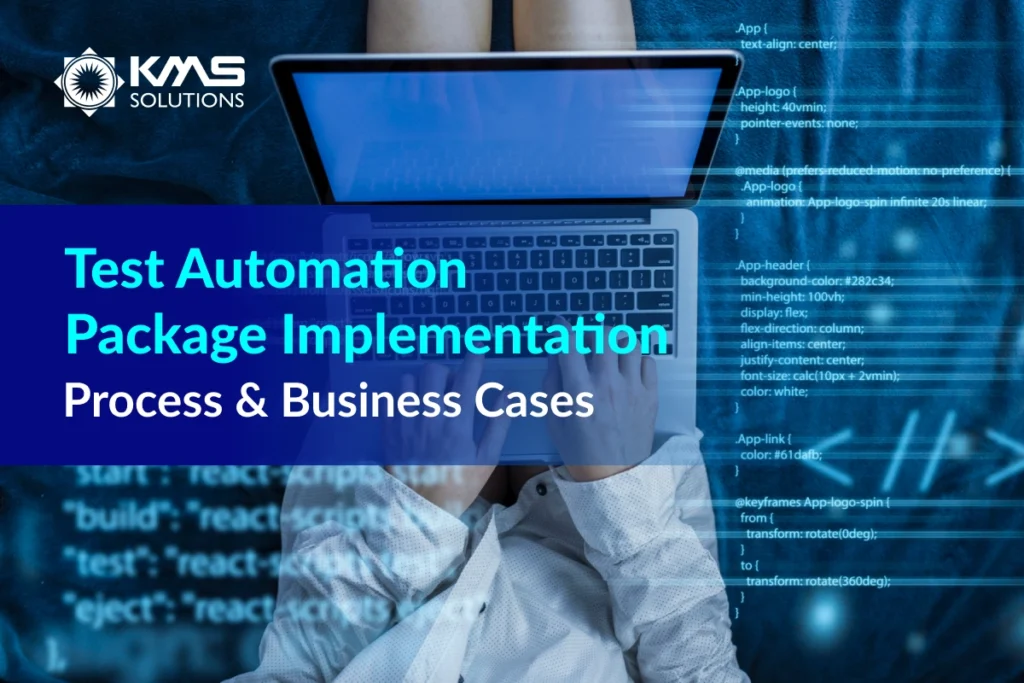In the high-stakes realm of software, where even the slightest errors can lead to substantial consequences, ensuring quality is of utmost importance. Among the various testing methods available, end-to-end testing and integration testing stand out as the two most common techniques. Understanding the distinctions between these two methodologies is crucial for software development teams to validate their systems effectively.
In this blog post, we will delve into these differences while highlighting each approach’s advantages.
What Is End-to-End Testing?

The end-to-end (E2E) testing approach verifies the entire flow of an application, from initial user interaction to final output.
During end-to-end testing, testers mimic real-world user interactions by replicating live data, ensuring all steps necessary for completing a specific task are thoroughly assessed. For instance, a banking application would entail testing functionalities such as account login, term saving creation, loan creation, bill payments, and fund transfers. Such user flow involves the interaction of hundreds of components, including APIs, databases, networks, and third-party integrations. The E2E testing process can be broken down into:
- Assessing the system flow: By simulating a sequential user experience, E2E tests can validate every interaction point within the application from the end user’s viewpoint. This approach allows testers to understand the software’s behavior throughout the user journey.
- Validating subsystems and layers: Applications are constructed on intricate infrastructure comprising multiple dynamic components. E2E testing aims to confirm the compatibility among these layers, spanning from the front-end UI to the underlying API and across both internal and external systems.
End-to-end testing example in banking software development
Here are the potential test cases:
- Verify navigation to the bill payment section.
- Ensure available bills are displayed accurately.
- Test searching for specific bills by payee or category.
- Check if bill details (amount, due date, payee) are presented correctly.
- Verify the selection of the desired bill for payment.
- Ensure the editing payment amount option works correctly (if applicable).
- Test if different payment methods (linked accounts, cards) are available.
- Verify that the confirmation screen displays the correct payment summary (amount, payee, date).
- Ensure successful transaction notification appears.
- Check if the transaction history reflects the completed payment
End-to-end testing approaches
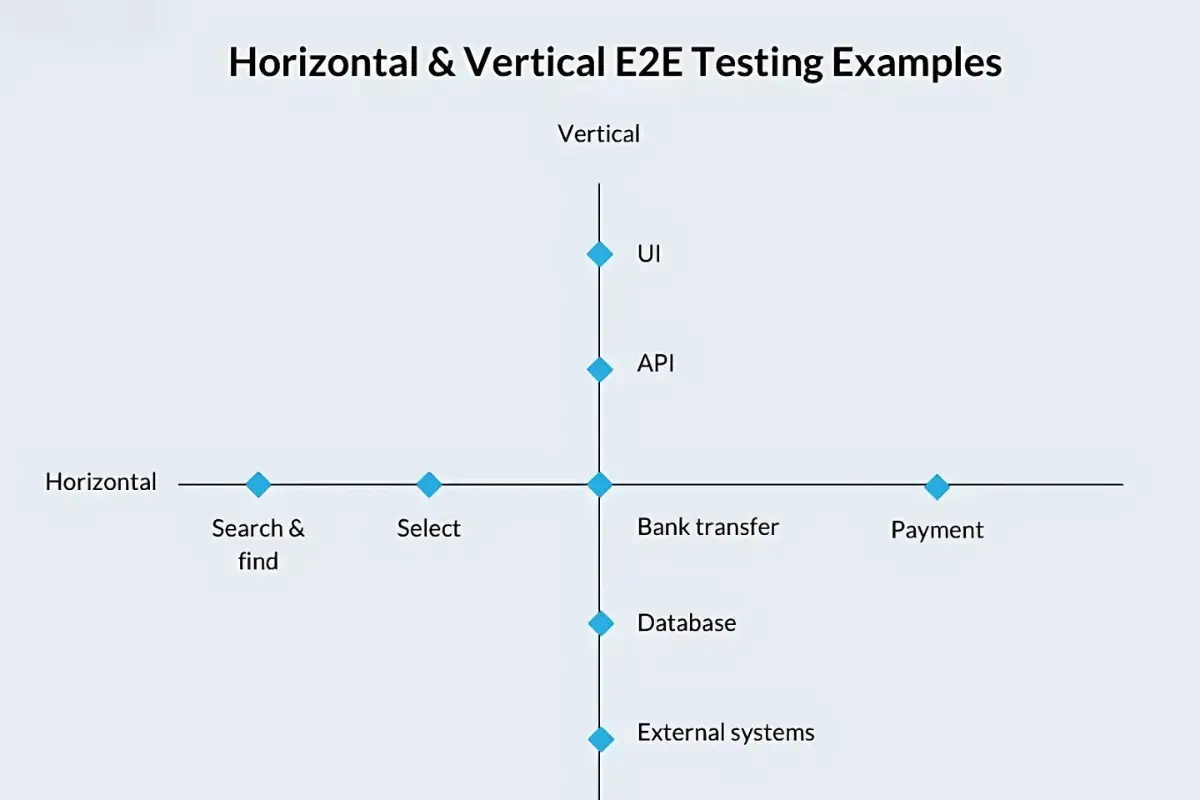
There are two different approaches to implementing end-to-end testing.
Horizontal
Horizontal end-to-end testing centers on replicating specific user pathways within an application. It encompasses all customer-facing aspects, including the app logic or user interface.
For instance, horizontal end-to-end testing might involve simulating the fund transfer process in a banking application. This entails verifying that users can seamlessly initiate a fund transfer, input recipient details accurately, authenticate the transaction securely, and receive confirmation of the completed transfer.
Vertical
The vertical end-to-end testing approach leans more towards the technical aspect, prioritizing testing in hierarchical layers. It systematically examines each layer of the application from top to bottom and is commonly employed to assess intricate computing systems that don’t rely on interfaces, such as databases or API calls
What Is Integration Testing?

Following unit testing and preceding end-to-end testing is integration testing, during which multiple modules are examined as a unified unit. Software typically consists of diverse modules crafted by separate developers. Each code unit may have been created with distinct requirements, functionalities, and limitations, and their integration could lead to unforeseen behaviors or errors.
Integration testing verifies the interfaces between modules, confirming the accurate data transmission and validating the proper functioning of modules when integrated.
Integration testing example
The goal of integration testing is to progressively integrate all modules while ensuring their proper functionality without causing any disruptions to other modules’ operations.
For an insurance application, here are potential integration test cases:
- Testing the integration between the UI and the policy management system: The app should display policy details accurately based on user input, such as coverage options and premium rates.
- Verifying the interaction between the app and the claims processing system: When a user submits a claim, the app should seamlessly transmit relevant information to the claims processing system. This includes details such as the nature of the claim, supporting documents, and contact information.
- Testing the integration with the payment gateway: The app should securely process premium payments and deduct the correct amount from the user’s account. Additionally, it should generate receipts and provide users with confirmation of payment.
Integration testing approaches
Integration testing can be conducted through various approaches, with the two most prevalent methods being the Big Bang and incremental approaches. In the Big Bang approach, all components are integrated simultaneously, and the entire system is tested comprehensively. Conversely, the incremental approach divides the software into manageable and logically connected modules, testing each subset before integrating them into the complete system.
Top-down approach
The incremental Top down approach is subdivided into two methodologies:
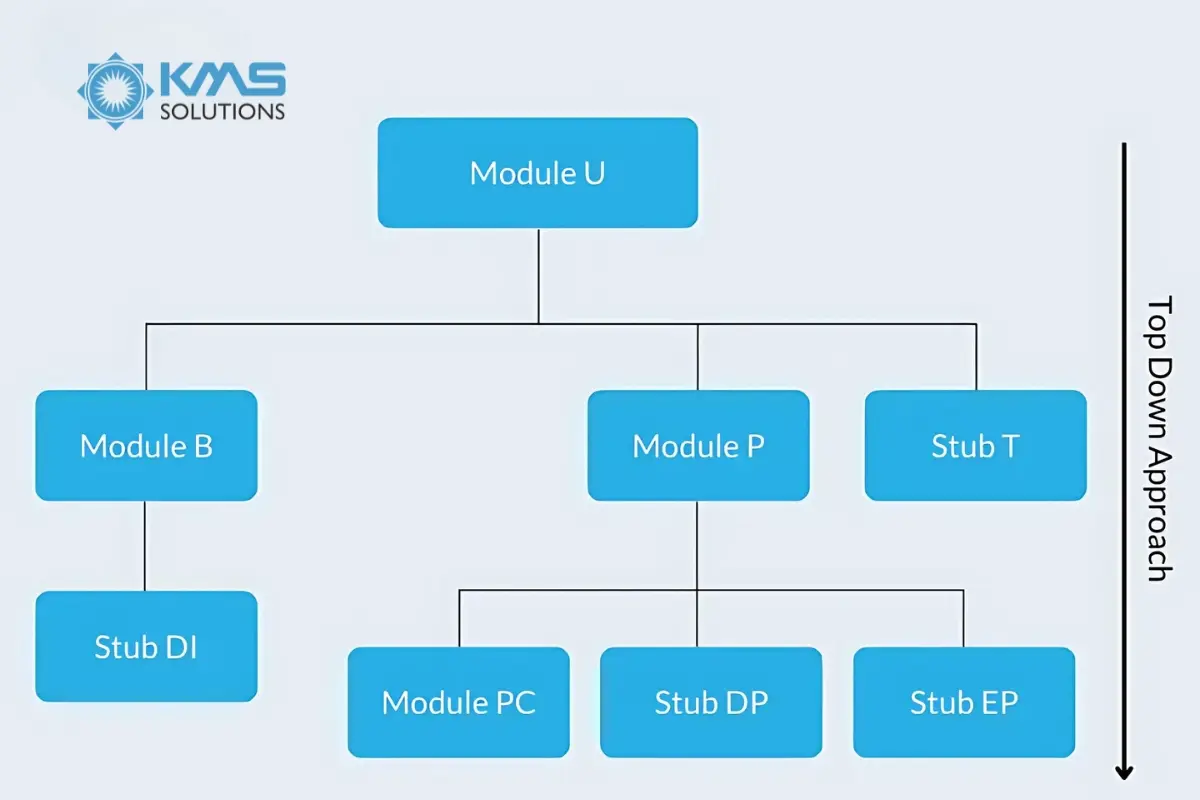
In the top-down approach, higher-level components of a software system are tested before the lower-level components. Developers frequently utilize stubs to mimic interfaces between the inaccessible or partially developed lower-level modules.
For example, the insurance application can consist of the following modules:
- Module U: Claims
- Module B: Policy Management
– Module policy information
- Module P: Claims Processing
- Module T: Payment Processing
– Module Debit Card/Credit Card Payment
– Module E-wallet Payment
For an incremental approach, the following test cases can be delivered:
- Test Case 1: Integrate and test Module U and Module B
- Test Case 2: Integrate and test Modules U, B, and T
- Test Case 3: Integrate and test Module U, B, T, and P
Bottom-up approach

- Unit Testing: Test individual modules responsible for tasks like user authentication, account management, transaction processing, etc. Unit tests ensure that each component behaves as expected when tested in isolation.
- Component Testing: Integration between the authentication and user account modules ensures that user credentials are properly validated and account information is retrieved correctly.
- Integration Testing: Test the interactions between different modules, such as transferring funds between accounts, updating account balances, or generating transaction histories.
- System Testing: The entire Internet banking application is tested as a whole to ensure that all components work together seamlessly. This includes testing the user interface, functionality across different browsers and devices, security features, performance under load, and other aspects of the application’s behavior.
- Acceptance Testing: Test specific scenarios or use cases relevant to banking operations, such as creating accounts, making transactions, and managing beneficiaries, according to the business requirements.
- Regression Testing: Retest previously tested features to confirm that they still work as expected whenever a new feature or component is added or change
End-to-End Testing vs Integration Testing: Key Differences
When it comes to software testing, two of the most common methods are End-to-end (E2E) Testing and Integration Testing. Though both are vital in the development lifecycle, their scopes are different. End-to-end Testing focuses on validating the complete functionality of an application, from the user’s perspective. In contrast, Integration Testing zooms in on ensuring that individual modules or components interact correctly.
- End to End Testing simulates real-world user scenarios to test the entire system.
- Integration Testing ensures different components or modules of the system work together as expected.
Understanding both approaches is crucial to improving software quality and ensuring it meets users’ expectations.
Here are the key differences between End to End Testing and Integration Testing:
| Feature | End-to-End Testing | Integration Testing |
| Scope | Entire application | Communication between modules |
| Focus |
|
|
| Execution | Simulates actual user behavior | Simulates interaction between modules |
| Tools | Selenium, Katalon, TestComplete | JUnit, TestNG, Mockito, Katalon |
| Challenges | Time-consuming, resource-heavy | Doesn’t simulate real-world scenarios |
| Technique | Black-box testing, usually employs user acceptance testing (UAT). | White-box testing, usually deploys API testing. |
| Testing stage | Conducted towards the end of the software development lifecycle, just prior to releases. | After unit testing and prior E2E testing |
| Test environment | Require a production-equivalent environment as they simulate real-world situations. This entails testing how your software interacts with external applications rather than solely focusing on an internal codebase, similar to an integration test. | Concentrates on the interactions among various software modules or components within the same codebase. |
| Data variations | Require diverse data sets for testing various user scenarios. | Provides greater control over each test. You can have individual data sets for each test, which makes it easier to update old tests or implement new data. |
When Should You Use End-to-End Testing and Integration Testing?
When Should You Use End-to-End Testing?
End-to-end testing should be your go-to when you need to ensure the full functionality of your system. It is particularly useful for:
- Complex applications where multiple systems interact.
- Validate real-world scenarios or complex systems.
- Scenarios where data flows are accurate between different systems, such as banking software or e-commerce platforms.
When Should You Use Integration Testing?
Integration Testing is ideal when you want to test how different parts of your application interact. Use it when:
- Ensure the application follow a modular architecture, such as microservices.
- Verify that different components can communicate and exchange data correctly.
- Test interfaces and data flow
- When unit testing is completed and want to verify component integration.
Benefits of End-to-End Testing and Integration Testing

Benefits of End-to-End Testing
- Enhanced test coverage: End-to-end testing extends its scope beyond unit testing and integration testing to validate all software functionalities, spanning from the API to the UI level. It ensures seamless interaction with all external elements the app relies on, such as third-party services, databases, and APIs.
- Cross-browser testing: End-to-end testing validates the front end, guaranteeing compatibility across diverse browsers, devices, and platforms.
- Minimized testing repetition: End-to-end testing covers comprehensive scenarios, use cases, and workflows, reducing the necessity for redundant testing of individual components. If a defect impacting the interaction between two modules is discovered, there’s no need to retest each module once the issue is resolved.
Benefits of Integration Testing
- Systematic method: Integration testing offers a structured approach to link various components of a software system while conducting tests to identify interface-related issues, such as inconsistent code logic or erroneous data.
- Performance issues identified: Integration tests aid in pinpointing performance bottlenecks that emerge with augmented data volumes, heightened processing loads, or resource constraints when components are amalgamated.
- Time-saving: Integration testing can start without waiting for all system modules to be fully coded and unit tested by utilizing stubs and drivers to substitute underdeveloped modules.
Best Practices for End-to-End Testing and Integration Testing
Best Practices for End to End Testing
End-to-end (E2E) tests present a distinct approach. Despite the significance of automation in streamlining testing processes, manual testing remains vital for comprehensive evaluation. Additionally, consider:
- Conducting tests covering the complete user journey.
- Testing for variables beyond your control.
- Crafting meaningful assertions to validate the application’s behavior.
- Employing concrete and realistic data to emulate real-world scenarios effectively.
- Testing across diverse environments to gain a comprehensive understanding of the application’s behavior.
Best Practices for Integration Testing
In automated integration testing, you can guarantee consistent execution by initiating the test immediately after successfully assessing individual units or components. Additionally, it’s suggested to:
- Conduct testing in small increments using a manageable set of components to facilitate targeted testing and streamline issue identification.
- Incorporate negative testing to detect unexpected behaviors, such as invalid inputs or edge cases, aiding in the identification of potential security vulnerabilities or other obscure issues.
- Maintain separate testing suites to provide developers with near-immediate feedback without impeding their progress.
Integration Testing in CI/CD Pipelines
Incorporating Integration Testing into your CI/CD pipeline ensures continuous testing of your software as changes are made. By automating integration tests, you can detect and fix interface issues early in the development process.
Tools like Jenkins and GitLab CI/CD help automate integration testing, ensuring faster feedback and more reliable deployments.
Combining Both Testing Approaches
The most effective testing strategies often combine both End to End Testing and Integration Testing. By doing so, you achieve comprehensive test coverage. End to End Testing ensures that your entire system works from a user’s perspective, while Integration Testing validates that the individual parts of your system can communicate effectively.
This combination provides a safety net, ensuring your application works at every level—from individual components to the entire system.
Are end-to-end and integration testing interchangeable?
Due to their variations in scope, focus, and methodology, E2E and integration testing can’t be interchanged. Instead, they complement each other by offering distinct levels of testing.
Integration testing is normally conducted initially to uncover any issues stemming from component interactions, ensuring seamless system functionality without integration bottlenecks. Meanwhile, End-to-End testing verifies whether the software meets real-world requirements and specifications.
Involving numerous APIs, modules, and systems, the two testing types have high complexity, making them ideal candidates for automation testing.
Although manual tests retain their importance, they are not exhaustive. Particularly in the case of large or complex systems, executing every test case and covering all scenarios may not be feasible. Moreover, ensuring a stable environment for end-to-end/integration testing presents challenges, as human error can easily disrupt testing scenarios with a single incorrect action.
Automated testing platforms can be a great solution for these challenges, allowing for more efficient, accurate, and stable E2E and integration tests.
Challenges and Limitations of End to End and Integration Testing

Challenges of End-to-End and Integration Testing
While both testing methods are essential, each comes with its own set of challenges.
- End to End Testing can be time-consuming and resource-intensive. Simulating real-world scenarios often requires complex setups and more resources.
- Integration Testing, while efficient, may not fully capture real-world user behaviors. Since it focuses on module interactions, some bugs related to overall system performance might slip through.
Overcoming Testing Challenges
To overcome these challenges:
- Automate Where Possible: Automation can help reduce the time and resources required for End to End Testing.
- Focus on High-Priority Test Cases: Prioritize critical user journeys and interface points to maximize efficiency and coverage.
- Use a Hybrid Approach: Combine End to End Testing and Integration Testing to cover both user experience and component interactions.
How KMS Solutions can help you level up your testing game
Despite the adoption of automated testing platforms, some institutions still find it difficult to leverage it to the fullest. This challenge arises from various factors, including skills gap, unsuitable tools, etc. This necessitates a tech partner with a proven track record in implementing automation testing for institutions to provide assistance.
With years of experience assisting companies in successfully transforming their testing processes, we excel in building a tailored strategy and suitable automation tools/frameworks that address their specific needs, regulations, budgets, and technical capabilities.
Our teams also specialize in developing test scripts for E2E and integration testing scenarios and provide comprehensive training sessions. Moreover, we’ve successfully helped many clients integrate automated testing into their CI/CD pipelines to facilitate faster feedback and deployment processes.
This enables our clients to accelerate software releases and achieve broader test coverage across complex systems, ultimately leading to improved software quality and reliability.
Our teams also specialize in developing test scripts for E2E and integration testing scenarios and provide comprehensive training sessions. Moreover, we’ve successfully helped many clients integrate automated testing into their CI/CD pipelines to facilitate faster feedback and deployment processes.
This enables our clients to accelerate software releases and achieve broader test coverage across complex systems, ultimately leading to improved software quality and reliability.




